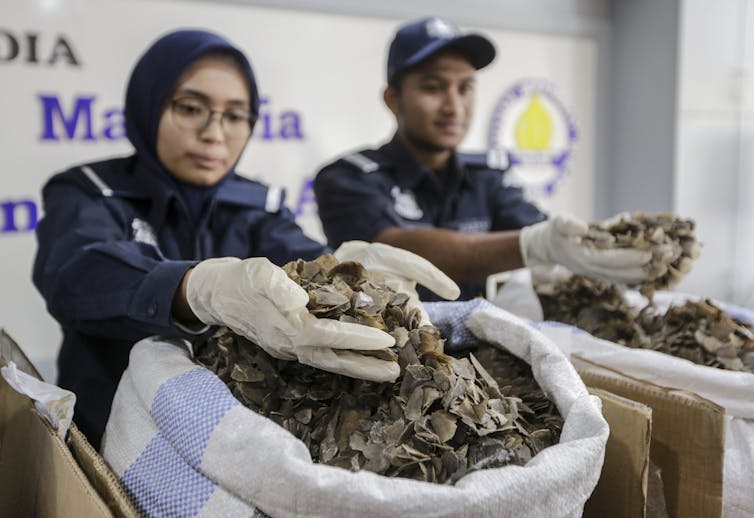Back from extinction: a world first effort to return threatened pangolins to the wild
- Written by Alexander Richard Braczkowski, Research Associate, Griffith University
Pangolins are one of the most illegally trafficked animals on the planet and are suspected to be linked to the current coronavirus pandemic.
Pangolins are also one of the world’s most threatened species but new efforts are underway to reintroduce pangolins to parts of Africa where the animal has been extinct for decades.
Read more: What Australian birds can teach us about choosing a partner and making it last
The reintroduction of pangolins has not been easy. But it’s vital to prevent this shy, mysterious creature from being lost forever.
A cute but threatened species
Pangolins are the only mammals wholly-covered in scales, which they use to protect themselves from predators. They can also curl up into a tight ball.
They eat mainly ants, termites and larvae which they pick up with their sticky tongue. They can grow up to 1m in length from nose to tail and are sometimes referred to as scaly anteaters.
But all eight pangolin species are classified as “threatened” under International Union for Conservation of Nature criteria.
There is an unprecedented demand for their scales, primarily from countries in Asia and Africa where they are used in food, cultural remedies and medicine.
Between 2017 and 2019, seizures of pangolin scales tripled in volume. In 2019 alone, 97 tons of pangolin scales, equivalent to about 150,000 animals, were reportedly intercepted leaving Africa.
 Pangolin scales seized by Royal Malaysian Customs at Kuala Lumpur International Airport in 2017.
EPA/Ahmad Yusn
Pangolin scales seized by Royal Malaysian Customs at Kuala Lumpur International Airport in 2017.
EPA/Ahmad Yusn
There is further evidence of the illegal trade in pangolin species openly on social media platforms such as Facebook.
The intense global trafficking of the species means the entire order (Pholidota) is threatened with extinction. For example, the Temminck’s pangolins (Smutsia temminckii) went extinct in South Africa’s KwaZulu Natal Province three decades ago.
Reintroduction of an extinct species
Each year in South Africa the African Pangolin Working Group (APWG) retrieves between 20 and 40 pangolins through intelligence operations with security forces.
These pangolins are often-traumatised and injured and are admitted to the Johannesburg Wildlife Veterinary Hospital for extensive medical treatment and rehabilitation before they can be considered for release.
In 2019, seven rescued Temminck’s pangolins were reintroduced into South Africa’s Phinda Private Game Reservein the KwaZulu Natal Province.
Nine months on, five have survived. This reintroduction is a world first for a region that last saw a viable population of this species in the 1980s.
During the release, every individual pangolin followed a strict regime. They needed to become familiar with their new surroundings and be able to forage efficiently.
 Pangolins curl up into a tight ball of scales.
Alex Braczkowski
Pangolins curl up into a tight ball of scales.
Alex Braczkowski
Previous releases, including early on in South Africa and in other countries such as the Philippines, the Democratic Republic of the Congo and Thailand had minimal post-release monitoring.
Pangolins released immediately following medical treatment had a low level of survival for various reasons, including inability to adapt to their release sites.
A ‘soft release’ in to the wild
The process on Phinda game reserve involved a more gentle ease into re-wilding a population in a region that had not seen pangolins for many decades.
The soft release had two phases:
- a pre-release observational period
- an intensive monitoring period post release employing GPS satellite as well as VHF tracking tags.
 A satellite tag is fitted to each pangolin before release and transmits its location on an hourly basis.
Alex Braczkowski
A satellite tag is fitted to each pangolin before release and transmits its location on an hourly basis.
Alex Braczkowski
The pre-release period lasted between two to three weeks and were characterised by daily walks (three to five hours) of individuals on the reserves. These walks were critical for acclimatising individuals to the local habitat, its sounds, smells and possible threats. It also helped them source suitable and sufficient ant and termite species for food.
Following that, the post release period of two to three months involved locating released pangolins daily at first, and then twice per week where they were weighed, a rapid health assessment was made and habitat features such as burrows and refuges monitored.
Phinda reserve manager Simon Naylor said:
A key component of the post release period was whether individuals gained or maintained their weight.
The way the animals move after release also reveals important clues to whether they will stay in an area; if they feed, roll in dung, enter burrows. Much of this behaviour indicates site fidelity and habitat acceptance.
Read more: No, Aussie bats won’t give you COVID-19. We rely on them more than you think
Following nine months of monitoring and tracking, five of the seven survived in the region. One died of illness while the other was killed by a Nile crocodile.
 Released pangolins are located at burrows like this one.
Alex Braczkowski
Released pangolins are located at burrows like this one.
Alex Braczkowski
Why pangolin reintroduction is important
We know so little about this group of mammals that are vastly understudied and hold many secrets yet to be discovered by science but are on the verge of collapse.
The South African and Phinda story is one of hope for the Temminck’s pangolin where they once again roam the savanna hills and plains of Zululand.
The process of relocating these trade animals back into the wild has taken many turns, failures and tribulations but, the recipe of the “soft release” is working.
Authors: Alexander Richard Braczkowski, Research Associate, Griffith University



